After an extensive search, I finally stumbled upon a tutorial on how to draw an adorable kitten. I’ve been wanting to find this post for quite some time, and now that I have, I am excited to share it with you.
Enthusiasts of avian creatures, here’s a fascinating list of the top 5 historically significant gray cardinals from around the world. These individuals have made an indelible mark on history.
Have you ever heard of the Great Man-Made River, often referred to as the eighth wonder of the world? It is a remarkable feat of engineering, but do you know who was responsible for its construction?
Step into the world of ancient beliefs and superstitions, where sorcerers and witchcraft held great sway. This pre-scientific worldview was dominated by these mystical practices.
–Summary
Irina Alexandrovna
–Search through diary
–Get updates via email
–Topics
- Embroidery (171)
- Beadwork (55)
- Embroidery on knitted fabric, ribbon embroidery (96)
- Time for Dinner (323)
- Baking (25)
- Meat, Poultry (23)
- Salads (14)
- Sauces, Gravies, Dressings (12)
- Soups (4)
- Design, Interior (138)
- Ideas for Gardeners (102)
- Home, Room, Kitchen Interiors (43)
- For Knitting Enthusiasts (3593)
- Crochet and Needlework Blouses (401)
- Pants, Skirts, Shorts, Suits (37)
- Knitting Videos (42)
- Knitting for Kids (752)
- Knitted Jewelry: Necklaces, Necklaces, Bracelets (47)
- Tips for Dressing a Curvy Lady (27)
- Lace (106)
- Housewares (74)
- Men (13)
- Crochet Dress (98)
- Dress with Knitting Needles (93)
- Helpful Knitting Advice (227)
- Crochet Patterns (186)
- Crochet Patterns (153)
- Crochet and Needlework Lessons (149)
- Crochet Patterns (4)
- Crochet Patterns (11)
- Bowler Hat (87)
- Exclusive Knitting (263)
- Caring for the Elderly (31)
- Law and Order (448)
- Housing and Utilities (14)
- Earning Online or How to Avoid Being a BOB (29)
- On Politics and Politicians (200)
- Global Events (308)
- Health (196)
- Movies (25)
- Stunning Photographs (124)
- The Enchantment of Gemstones (50)
- The Magic of Imagination (184)
- Various Forms of Creativity (48)
- Proverbs, Tales, Legends, Histories (207)
- Engaging Short Stories (116)
- Parables (48)
- Fairy Tales from Elfika (8)
- FASHION (and all things related) (114)
- Wisdom from the Wise (504)
- Thoughts, Quotes, Advice from the Famous (227)
- Psychology, Esoterics (222)
- For Gentlemen (68)
- Homemaker’s Corner (46)
- Our Little Ones (874)
- Education (327)
- Fairy Tales, Stories (7)
- DIY Projects for Kids and Parents (158)
- Games, Cartoons, Movies (21)
- Mastering Pencil Drawing (68)
- Mastering Paintbrush Techniques (30)
- Pergamano (16)
- Handicrafts (118)
- Russian language (91)
- Stencils (3)
- Drawing Lessons for Children and Adults (253)
- I learn to draw with pencils and paints (personal) (7)
- Nature (887)
- Trees, forests, groves (1)
- Traveling (100)
- Exploring the World Online (35)
- Artworks by Various Artists (549)
- Watercolor, Oil, Pencil Art (364)
- Painting Videos (5)
- Artworks from Past Centuries (116)
- Animals, Birds (54)
- Pictures, Animation, Holidays (87)
- Portraits (90)
- Nature, Village Scenes (62)
- Drawings with a Simple Pencil by Various Artists (7)
- Artists’ Perspectives on Children (96)
- Flowers, Still Lifes (54)
- Computers and Their Programs (278)
- HTML – reference sheets, codes, snippets, buttons, images (27)
- image generators, photographs (16)
- Text Generators (3)
- How to capture a screen image (8)
- Keyboard shortcuts or hotkeys (12)
- Photoshop (58)
- Reference sheets (57)
- Religion (482)
- Bible (its use among people) (275)
- Koran (15)
- All About Prayers (10)
- Comprehend and assimilate what you have learned (236)
- Galaxies, Universe, Space (55)
- other, diverse religions (239)
- Icons (42)
- Judaism (217)
- Holidays, beliefs, rituals, customs (153)
- Satanism and interpretation of biblical “flights” (192)
- Temples, cathedrals, churches (73)
- Russia (340)
- History of the Yusupov Family (16)
- How it was and what can be (59)
- Moscow in the past and present: history and stories (56)
- Romanovs: historical facts (13)
- That Which Must Not Be Forgotten (67)
- Poems I enjoy (176)
- Irina Samarina-Labyrinth (8)
- Lessons on setting up a blog on LiRu (122)
- What to give to my dear man (5)
- Humor (103)
–Tags
–Applications
- Always accessibleNo equivalents ^_^ Allows you to embed a panel with custom Html code into your profile. It is possible to place banners, counters, and other elements there
- Greeting cardsA revived catalog of greeting cards for all occasions
- Blog DirectoryA directory of blogs that allows you to categorize and easily find the necessary and interesting blogs among the vast number of blogs on the li.ru website
 ConverterCase Converter
ConverterCase Converter- TorrNADO – blog torrent trackerTorrNADO – torrent tracker for blogs
–Always within reach
–Interests
–Friends
–Regular readers
–Communities
–Statistics
The name Dubhe (Alpha of the Big Dipper) originates from the Arabic phrase – “the back of the big bear.”
Megrez (δ) is referred to as the “base of the tail.” It is the least bright star among the stars of the Big Dipper.
Mizar (ζ) means “girdle” or “belt” in Arabic. Near Mizar is another star called Alcor. It is interesting to note that the ability to distinguish these two stars is a result of good eyesight (with myopia not exceeding 1 diopter).
Benetnash (η), also known as Alkaid, is the third most luminous star in the constellation Ursa Major. The term “Al-qa’id banat nash” is of Arabic origin and it translates to “leader of the mourners.”

The constellation known as the Big Dipper was officially recorded by the Greek astronomer Ptolemy. This particular constellation is highly recognizable and has been observed and studied for countless generations. It held significance to astronomers in various ancient civilizations such as Egypt, Babylon, China, and Greece. It was notably included by Claudius Ptolemy in his extensive work known as the “Almagest” during the 2nd century, which served as a comprehensive compilation of astronomical knowledge during that era.
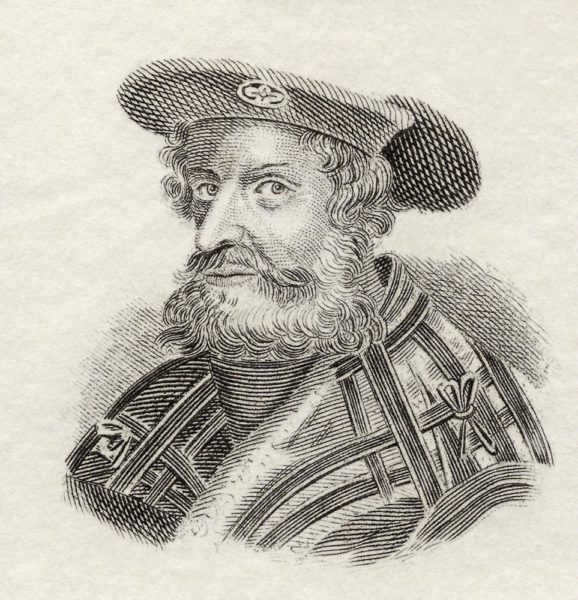
Ursa Major (also known as the Big Dipper) is a constellation located in the northern hemisphere of the sky. The Big Dipper is formed by seven stars that create a shape resembling a bucket with a handle. The two brightest stars in this constellation, Aliot and Dubhe, have an apparent sidereal magnitude of 1.8. By using the two outermost stars (α and β) of this formation, one can easily locate Polaris. The prime time for observing Ursa Major is between the months of March and April. It can be seen throughout the year in Russia, except during the autumn months in the southern region, when the Big Dipper appears low on the horizon.
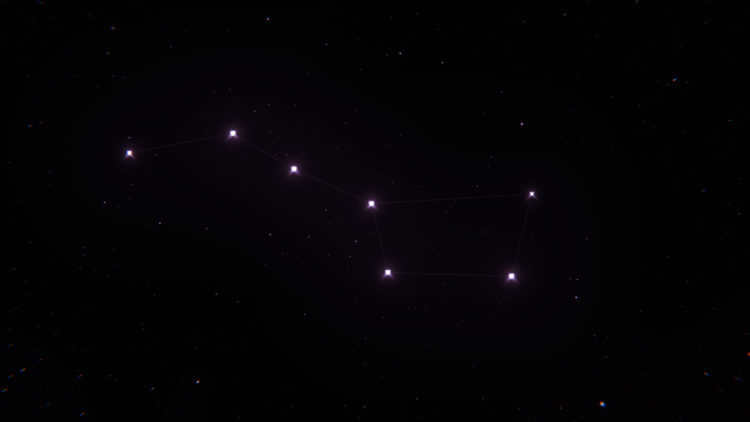
The ancient Egyptians were pioneers in the field of astronomy, with some of their circular stone “observatories” dating back to the fifth millennium B.C. They played a crucial role in developing the system of constellations, which was later adopted by civilizations such as the Greeks, Arabs, and modern science.
During that ancient era, due to the precession of the Earth’s axis, the northern celestial pole was not marked by Polaris, but rather by Alpha of the Dragon (Tuban).
In the eyes of the Egyptians, the surrounding area and its closest stars were known as the “fixed sky” and believed to be the abode of the gods. Instead of a ladle, the priests were able to observe the foot of Seth, the deity associated with war and death, who transformed into a bull and fatally struck Osiris with a powerful kick. In an act of vengeance for his father’s murder, Horus, who had a thick skull, severed one of Seth’s limbs.
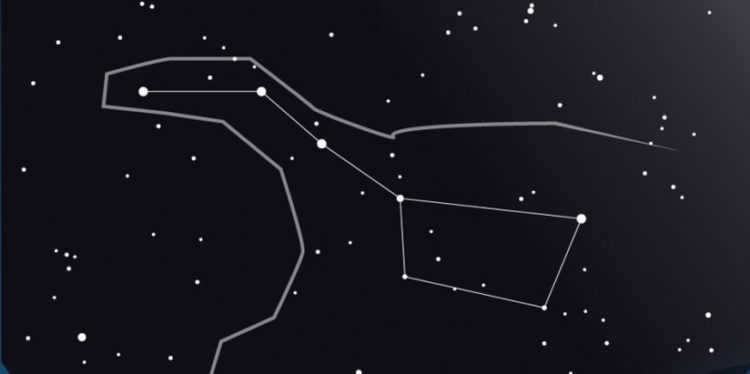
Undoubtedly, the origin of the constellation can be traced back to Greek mythology, with various versions and adaptations. However, they all share a common underlying theme – the preservation and understanding of the vast cosmic knowledge embedded in the universal realm.
The Great Bear is included in Ptolemy’s star catalog from about 140 BC, although its mention can be traced back even further, all the way to Homer.
The intricate Greek myths provide various explanations for its appearance, although they all agree that the bear is the beautiful Callisto, companion of the goddess Artemis. According to one version, using his usual tactics of reincarnation, the amorous Zeus seduced her, provoking the wrath of his wife Hera and Artemis herself. Saving his lover, the god of thunder transformed her into a bear, who roamed the mountain forests for many years until her own son, fathered by Zeus, found her while hunting. The supreme deity had to intervene once again. To prevent maternal murder, he brought both of them to the heavens.
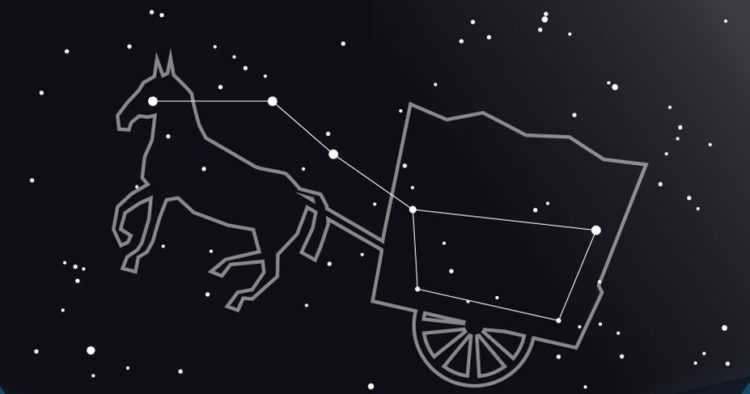
In ancient China, astronomers divided the celestial sphere into 28 vertical sectors known as “houses”. These houses represent the path of the Moon on its monthly journey. Similarly, in Western astrology, the Sun passes through the signs of the Zodiac on its annual rotation, a division borrowed from the Egyptians. At the center of the sky, like an emperor in the capital, the Chinese placed Polaris, which had already assumed its usual position. Honorable proximity to Polaris are the seven brightest stars of the Big Dipper, contained within the Purple Enclosure. This enclosure is one of three enclosures that surround the palace of the “royal” star. These stars can be described as the Northern Bucket, as their orientation corresponds to the seasons, or as part of the carriage of the Heavenly Emperor Shandi.
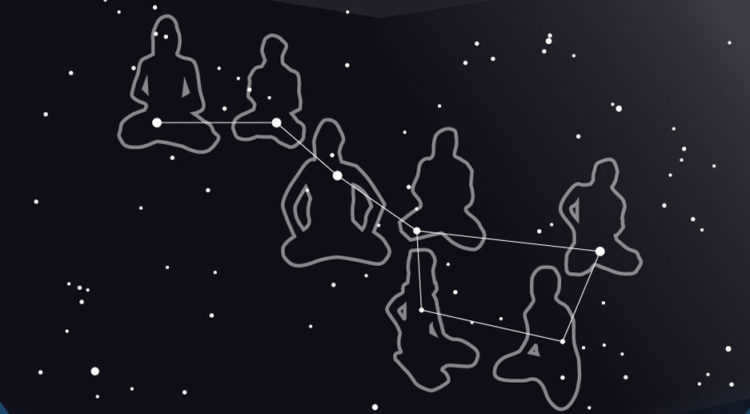
Ancient India’s progress in observational astronomy was not as remarkable as its advancements in mathematics. The concepts and ideas were heavily influenced by the knowledge from Greece and China. For instance, the 27-28 “stands” (nakshatras) that the Moon passes through in about a month bear a striking resemblance to the lunar “houses” in Chinese astronomy. Additionally, Hindus held a significant reverence for Polaris, which was believed to be the dwelling place of Vishnu according to the experts of the Vedas. The asterism known as the Bucket, situated beneath Polaris, was considered to be Saptarisha – the seven sages who were born from Brahma’s mind and served as the ancestors of our current epoch (Kali-yuga) and all beings inhabiting it.
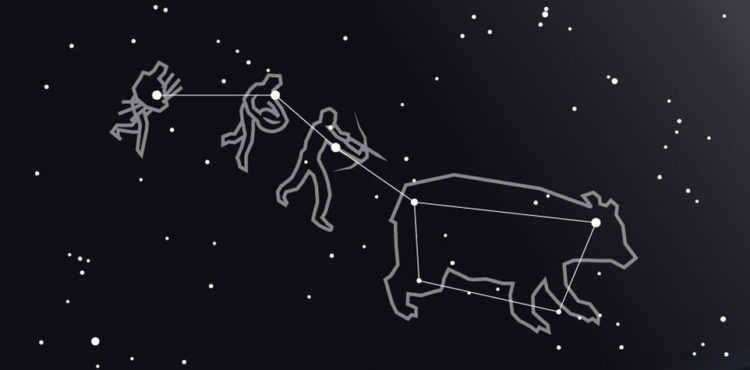
It appears that the Native Americans possessed some knowledge about untamed creatures: according to the Iroquois myth regarding the creation of the constellation, the “celestial bear” is depicted without a tail. The three stars that form the handle of the Big Dipper represent three hunters pursuing the beast: Aliot wields a bow with an arrow firmly lodged in it, Mitzar carries a cauldron for cooking meat (Alkor), and Benetnash is depicted with a stack of kindling to light the hearth. During autumn, as the Dipper rotates and descends closer to the horizon, blood from the wounded bear drips down, painting the trees in a patchy array of colors.
The star South Alula or xi of the Big Dipper is the closest among the brightest stars in the constellation. When observed through a telescope with a lens larger than 80mm, it appears as a beautiful double star, with each component similar in characteristics to the Sun. Interestingly, both components also have a companion – a cold red dwarf!
On the other end of the spectrum, we find the star μ of the Big Dipper, located furthest away from the brightest stars in the constellation. This star, also known as the red giant, can be found in the front “paw” of the Dipper. Its distance from us is estimated to be 249 light years.
The flag of Alaska features the constellation of the Big Dipper. Similarly, the flag of White Sea Karelia, approved on June 21, 1918, also includes the Big Dipper. Additionally, Irish left-wing radical organizations use a flag adorned with the image of the Big Dipper.
Even during the daytime, one can marvel at the Big Dipper. It can be easily located on various interactive constellation maps, which also showcase other notable constellations for closer examination.
Undoubtedly, the expansive Big Dipper constellation is a true haven for avid astronomy enthusiasts! Within this celestial region, there are numerous celestial wonders that can be observed with small telescopes, such as double and variable stars, bright and faint galaxies, a scattered star cluster, and even a planetary nebula.
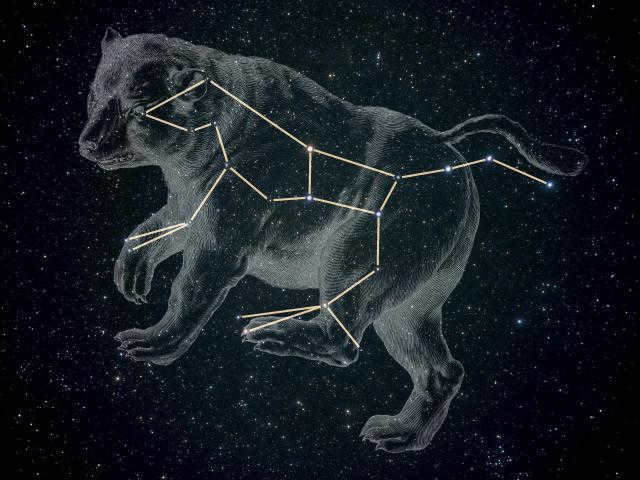
Since ancient times, the night sky has captivated the attention of individuals. It has served as a means of understanding, admiration, motivation, acquiring new knowledge, and a navigational tool for long voyages. Mariners have utilized the night sky to navigate the vast seas and oceans, while explorers have sought celestial guidance to determine their bearings and reach their desired destinations.
Through extensive observation, people have discerned a correlation in the relative arrangement of celestial objects – a system that enables them to categorize these objects into constellations. Constellations are recognizable patterns or shapes formed by prominent stars, and the term has evolved to encompass entire sections of the night sky. A single constellation can encompass both nearby and distant objects, which may not be related, but their arrangement creates a distinct pattern.
One of the most well-known constellations is the Big Dipper, a pattern that has been familiar to us since childhood. References to it can be found in the writings of Homer, Shakespeare, and even in the Bible. This constellation is easily identifiable in all corners of the globe. If you are a casual stargazer or a future astronomer, studying the Big Dipper is a great place to start.
Amongst the various images and photographs displayed on the Internet portal, one can locate the grouping of seven stars known as the Big Dipper – the most identifiable component of the constellation. Resembling a bucket with a handle, this asterism includes the stars Dubhe, Merak, Fekda, Megretz, Aliot, Mitsar, and Benetnash. Throughout history, this constellation has been known by different names among various cultures. This is because thousands of years ago, the constellation had a different appearance and people observed different formations within it, unlike what we perceive today. It is possible that in the future, the constellation will undergo further changes.
Distinctive Features
The Ursa Major constellation stands out as one of the largest constellations in terms of its expanse. It is easily recognizable, as it has been a familiar sight since childhood. It holds the third position in size, following Hydra and Virgo. The constellation consists of a total of 200 stars, with 125 of them visible to the naked eye during a moonless night with clear weather conditions. Positioned in the northern hemisphere, it shares borders with eight other constellations. In 1922, scientists determined that the Ursa Major constellation covers an area of 1279.66 square degrees. The boundaries were established by Eugene Delporte in 1930. It has been calculated that the constellation occupies 3.10% of the total sky, making it easy to observe its individual components.
There are numerous double luminaries in the Great Bear, but the majority of them are faint or too close together to be discerned without the aid of telescopes. This category also encompasses a variety of intriguing and uncommon galaxies that captivate with their stunning beauty and uniqueness.
Renowned entities
The constellation boasts a multitude of remarkable entities. However, it is most renowned for the asterism consisting of the seven prominent stars. This segment represents the hind legs and tail of the animal, forming the distinct shape of a dipper. It is easily visible in the night sky due to the high luminosity of the majority of the stars present.
- The most brilliant star is Aliot. It is situated 81 light-years away from Earth and is located in the “tail” of the bear within the constellation of the Dipper. It holds the 33rd position in terms of luminosity.
- Merak is a bright white star with a magnitude of 2.37. It has a radius and mass three times that of the Sun. Moreover, the surface temperature of Merak is twice that of the Sun.
- Megrez is a white star situated approximately 60 light-years away from Earth. It holds the fourth position in terms of brightness. It can be found at the juncture of the body and tail of the Bear or the dipper and handle.
- Phecda is a hot white dwarf that belongs to the moving group of the Big Dipper. It is around 0.3 billion years old and reaches a temperature of 9,355 K.
- Mizar is positioned at the tip of the dipper’s handle. It is located 78 light years away from Earth. This star is known for its high temperature. It also has a “close neighbor” called Alcor, which is situated a quarter of a light year away. This system was officially recognized as a double star for the first time in history.
Legends and Myths Surrounding the Big Dipper and the Little Dipper
The origins of the names of the stars in the Big Dipper are still unknown, but they are often seen as symbolic. Many of the stars are named after different parts of a bear’s body, such as Fekda, which means “thigh,” and Mitsar, which means “belt.” Typically, celestial bodies are named using letters of the Greek alphabet based on their brightness. However, various cultures interpret constellations in a wide range of ways, seeing them as everything from camels and sharks to skunks and canoes.
If you want to get a clear view of the Big Dipper constellation, simply gazing at the night sky won’t suffice. Up there, you’ll only be able to spot a group of stars, not the actual shape of the celestial animal. To truly appreciate its form, you can refer to an online photo that showcases the constellation’s model. Alternatively, for the younger ones, an interactive map that provides detailed descriptions of all its components can be utilized.
Aside from the Big Dipper, there is also the Small Dipper. Their names are linked to a common myth. The tale goes that in ancient Greece, there resided a girl named Callisto. She was so beautiful that others became consumed with envy and transformed her into an ugly bear. Zeus, concerned that the bear might be harmed, placed it in the sky. He held onto the bear by its tail as he cast it into the heavens. The Small Bear, on the other hand, is Callisto’s dog, who was also positioned in the sky. Other sources claim that the Small Bear is the offspring of Callisto and Zeus.
According to another myth, the seven stars of the Small Bear are maidens who took a daring leap up a mountain while fleeing from the formidable king of the devas. To remain together, they arranged themselves closely and began to emit a brilliant shine.
What is the best time to observe this constellation in the sky?
The Big Dipper can be seen in the sky all year round, but the ideal time for observation is during the months of March and April. Even those with little knowledge of astronomy can easily locate the distinctive pattern of 7 stars that form the dipper. These stars are among the first to appear in the night sky and are the brightest.
In order to make accurate observations, it is important to choose a suitable location with unobstructed views. It is best to avoid areas with bright streetlights. An open area outside of the city, such as a mountain or hill, is ideal. Additionally, it is important to have a good sense of direction and be familiar with the surrounding terrain. You can use a compass or look for the North Star, just as our ancestors did.
To locate the whereabouts of the Big Dipper, all you have to do is gaze upwards and spot the collection of stars by its distinctive shape. The prominent Big Dipper is impossible to overlook in the nocturnal expanse. While the constellation can be seen from any vantage point, its visibility diminishes the closer one gets to the southern pole.
Observing the night sky is a truly enchanting ritual, imbued with a sense of magic. It serves as a wellspring of inspiration for the creation of something new. Some individuals opt to capture the stars on paper, comparing their sketches across different seasons, penning captivating tales, composing poems and songs, or simply swaying to their favorite tunes.
Everything in nature is in perpetual motion, and the stars are no exception. Consequently, the Bear occupies different parts of the firmament at various times of the year, yet it always remains distinctly visible under favorable weather conditions.
From our earliest years, we have been informed about the Big Dipper constellation in the autumn sky, situated in its northern region. It is during this time that it truly shines, exuding a captivating beauty. In autumn, the radiance emitted by celestial objects may be less intense, but there are other constellations to behold as well, including the Little Bear, Gemini, Taurus, Lyra, and Swans.
Did you know?
If you have a fascination with astronomy or enjoy stargazing, you may find these intriguing facts about the Big Dipper fascinating:
- The Big Dipper is prominently featured on the flags of White Sea Karelia and Alaska;
- The seven stars that comprise the Big Dipper have been recognized since the Neolithic period;
- It can serve as a reliable tool for determining the exact direction of north, regardless of your location;
- The Big Dipper is one of the original 48 constellations cataloged by Ptolemy in the second century BC;
- Within the Big Dipper, there are several captivating and visually stunning galaxies, such as Messier, a planetary nebula discovered by scientists in 1781, as well as M101, M81, M82, M108, and M109;
- The renowned Deep Field photograph taken by the Hubble Space Telescope showcases over 3,000 galaxies and was captured within the expanse of the Big Dipper.
- It wasn’t until 2009 that the revelation came about that Mizar and Alcor form a six-star system;
- The Ursa Major constellation, also known as the Great Bear, remains visible above the horizon every night, as passed down by the ancient Greeks;
- Scientists speculate that this constellation could potentially serve as a hub for extraterrestrial intelligence. In fact, it was here that the star 47 UMa, which boasts a planetary system resembling our own, was discovered. Additionally, a radio message was transmitted from this very location in 2003;
- Legend has it that in ancient Sparta, Mizar and Alcor were utilized to test the visual acuity of warriors. Only those with exceptional eyesight were able to discern them as two distinct stars;
- The origins of the Big Dipper constellation are shrouded in mystery, as references to it can be found throughout various cultures and time periods. Some believe that its name has persisted for over a hundred thousand years.
Previously, we were under the impression that the Big Dipper consisted of seven prominent stars. However, it turns out that it is actually comprised of an abundance of galaxies and celestial bodies that we witness on a daily basis in the heavens above. Through various pictures, it becomes evident that this is an exceptionally captivating spectacle, housing numerous entities that captivate the attention of astronomers and aficionados of outer space alike. If you desire to witness the genuine marvel of the nocturnal sky, all you need to do is cast your gaze upwards.
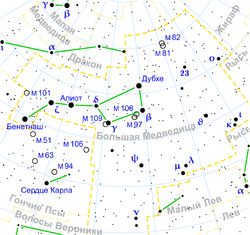
The Great Bear (also known as Ursa Major) is a constellation that can be seen all year round in the northern hemisphere. The Big Dipper, which is formed by seven stars, resembles a ladle with a handle. The two brightest stars, Aliot and Dubhe, have a brightness of 1.8 apparent sidereal magnitude. Polaris, also known as the North Star, can be found by following a line from the two outermost stars (alpha and beta). The best time to see the Great Bear is in March and April. It is visible throughout Russia.
Asterisms
Asterisms are groups of stars that form recognizable patterns within constellations. These patterns are often much smaller and more familiar than the entire constellation they belong to. Asterisms can help stargazers easily locate and identify specific stars or constellations in the night sky. Some well-known asterisms include the Big Dipper in the constellation Ursa Major and the Summer Triangle formed by the stars Vega, Deneb, and Altair. Exploring and learning about different asterisms can enhance your understanding and enjoyment of the night sky.
The Big Dipper is the third largest constellation by area, and it is famous for its seven bright stars that form the well-known asterism called the Big Dipper. This group of stars has been recognized since ancient times by various cultures and has been given different names such as the Plow, the Elk, the Wagon, and the Seven Sages. Each star in the Big Dipper has its own Arabic name. Dubhe (α) means “bear”; Merak (β) means “loins”; Fekda (γ) means “thigh”; Megretz (δ) means “beginning of the tail”; Aliot (ε) has an unclear meaning; Mitsar (ζ) means “girdle” or “loincloth”. The final star in the handle of the Big Dipper is called Benetnash or Alqaid (η), which in Arabic means “leader of the mourners”. This poetic description comes from the Arabic folk understanding of the Big Dipper constellation. The use of Greek letters to designate the stars in order of decreasing brightness in the Big Dipper is not completely fair, as the letters simply follow the order of the stars.
Interestingly, the 5 inner stars of the Bucket (excluding the outermost α and η) actually make up a single constellation in space known as the moving cluster of the Big Dipper. This cluster moves quite rapidly across the night sky, with Dubhe and Benetnash moving in the opposite direction. As a result, the shape of the Bucket undergoes significant changes over a span of approximately 100,000 years.
The stars Merak and Dubhe, which form the wall of the Bucket, are commonly referred to as the Pointers because the straight line drawn through them leads to Polaris, the North Star, located in the constellation of the Little Bear. All the stars within the Bucket possess a brightness ranging from 2 to 3 stellar magnitudes.
In 1650, Riccioli observed that the 4th magnitude star Alcor (80 of the Big Dipper) could be seen with a keen eye. The name Alcor means “forgotten” or “insignificant” in Arabic. Throughout history, the ability to spot Alcor has been considered a test of eyesight. The combination of Mizar and Alcor is often referred to as the asterism “Horse and Rider”.
An Arabian asterism known as “The three jumps of the gazelle” consists of three pairs of stars that are closely spaced and aligned in a straight line. The pairs are evenly spaced apart and represent the hoofprints of a gazelle leaping. The stars included in this asterism are:
Different items
In the area of the Big Dipper, there are numerous galaxies and clusters of galaxies. The M 101 spiral galaxy appears flat, while the M 81 spiral galaxy and the M 82 spindle-shaped galaxy, which are only 38′ apart, make up the core of what could be the nearest group of galaxies to us, located approximately 7 million light-years away. However, the M 97 Owl, a planetary nebula that lacks distinctive features, is much closer to us – it is actually within our own Galaxy. In 2002, astronomers from the University of Texas at Arlington made a significant discovery: they found two exoplanets orbiting the 47th star in the Big Dipper.
Historical Background
The history of this ancient constellation can be traced back to the early days when it was primarily associated with the prominent asterism known as the Big Dipper. The Greeks, in particular, gave it various names such as Helica (meaning “shell”), Arctos (meaning “bear”), and Chariot. Among these names, Arktos is considered the oldest and is believed to have originated during the era of hunting. Greek authors, like Aratus of Soli, mention that the constellation was used by ancient Greek navigators.
According to Greek mythology, one of the popular tales surrounding this constellation is the transformation of the beautiful nymph Callisto into the Dipper, as a means to protect her from the wrath of Hera. Another myth, recounted by Philemon of Syracuse, revolves around two Cretan nymphs who were also transformed into bears by the young Zeus, as a way to hide them from Cronus. Eventually, these bears were elevated to the sky, forming the Big and Little Dippers.
In Chinese astrology, the Northern Bucket (Beidou) is the name given to the seven stars of the dipper. In ancient times, the Chinese used the handle of the bucket, which pointed almost to the pole, as a means of telling time.
Fun facts
- The constellation of the Big Dipper is featured on the flag of Alaska.
- The constellation of the Big Dipper is also featured on the flag of White Sea Karelia (approved on June 21, 1918) with white stars set against a blue background.
- The region depicted in the Hubble Deep Field image falls within the constellation of the Big Dipper.
Gallery

The illustration by Sidney Hall portrays the formation of the constellation known as the Big Dipper

Jan Hevelius’ atlas features the emergence of the Big Dipper constellation.

Starry Night over the Rhone is an artwork created by the famous artist Vincent van Gogh
Sources
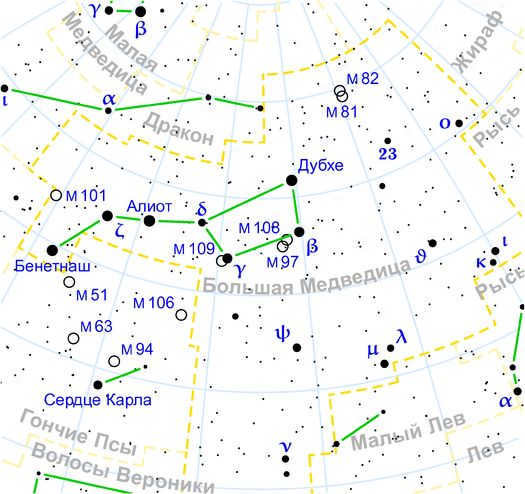
The constellation Ursa Major, also known as the Big Dipper, can be seen in the northern hemisphere of the sky. It is characterized by a group of seven stars that form a shape resembling a ladle with a handle. The two brightest stars in this constellation, Aliot and Dubhe, have an apparent sidereal magnitude of 1.8. By following the line connecting the two outermost stars (α and β), one can locate the North Star, Polaris. The best time to observe Ursa Major is during the months of March and April. It is visible throughout Russia all year long, with the exception of the autumn months in southern Russia when the constellation dips down close to the horizon.
Stars and constellations
The Big Dipper is the third largest constellation (after Hydra and Virgo) in terms of area, and it is characterized by its seven bright stars which form the well-known Big Dipper. This group of stars has been recognized since ancient times by various cultures under different names, such as Plow, Elk, Wagon, Seven Sages, and more. Each star in the Big Dipper has its own Arabic name: Dubhe (α) means “bear”; Merak (β) means “loins”; Fekda (γ) means “thigh”; Megretz (δ) means “beginning of the tail”; Aliot (ε) – the meaning is unclear; Mizar (ζ) means “girdle” or “loincloth”. The final star in the handle of the Big Dipper is known as Benetnash or Alqaid (η), which translates to “leader of the mourners” in Arabic. This poetic interpretation derives from the Arabic folklore surrounding the constellation of the Big Dipper. In the system of assigning Greek letters to stars, the order of the letters simply corresponds to the order of the stars.
Interestingly, the 5 inner stars of the Bucket (excluding the outermost α and η) actually belong to a single group in space known as the moving cluster of the Big Dipper. This cluster moves quite rapidly across the sky, with Dubhe and Benetnash moving in the opposite direction. As a result, the shape of the Bucket undergoes significant changes over a span of approximately 100,000 years.
The stars Merak and Dubhe, which form the wall of the Bucket, are commonly referred to as the Pointers because a straight line drawn through them points directly to Polaris, located in the constellation of the Little Bear. Out of the six stars in the Bucket, five have a brightness level of the 2nd magnitude, while Megrets has a brightness level of the 3rd magnitude.
Riccioli observed Mizar and Alcor in 1650; it is believed that Galileo may have observed them as a double as early as 1617 [1]). Alcor, also known as the star Alkor, is a 4th magnitude star located in the Big Dipper constellation. Its name is Arabic for “forgotten” or “insignificant”. Throughout ancient times, the ability to distinguish Alcor has been considered a test of eyesight. The pairing of Mizar and Alcor is often represented as the asterism “Horse and Rider”.
An asterism of Arabian origin called “The three jumps of the gazelle” consists of three pairs of closely spaced stars. These pairs are aligned in a straight line and separated by equal distances, resembling the hoofprints of a gazelle moving by leaps. The stars included in this asterism are:
Aliot, Mizar, and Benetnash create an elongated curve that directs towards Arcturus, the most brilliant star above the celestial equator and also the most visible star in spring in the middle latitudes of Russia. As this curve extends further south, it points to Spica, which is the brightest star in the Virgo constellation.
Laland 21185, a red dwarf situated near Alula North and not visible to the naked eye, is one of the nearest star systems to Earth, with only Alpha Centauri, Barnard’s Star, and Wolf 359 being closer. Another star that can be observed with binoculars is Groombridge 1830, which is second only to Barnard’s star and Kapteyn’s star in terms of its own movement. Over a hundred years, it moves about a third of the lunar disk [2].
Other celestial objects
In the region of the Big Dipper, there are numerous galaxies and clusters of galaxies. The spiral galaxy M 101 appears flat when observed, while the spiral galaxies M 81 and M 82, which are separated by an angle of only 38′, are believed to be the closest group of galaxies to us, located approximately 7 million light-years away. However, the Owl nebula (M 97), which is one of the largest planetary nebulae, is much closer to us within our own Galaxy. It is hundreds of times nearer than the aforementioned galaxies. In 2002, astronomers from the University of Texas at Arlington made a significant discovery of two exoplanets orbiting the star 47 in the Big Dipper. Furthermore, in 2001 and 2003, radio messages were transmitted from Earth to potential extraterrestrial civilizations targeting this particular star.
Historical Background
The history of this constellation dates back to ancient times. It was initially associated with the prominent star formation known as the Big Dipper. In ancient Greece, it was referred to by different names such as Helica (meaning “shell”), Arctos (meaning “bear”), and Chariot. Among these names, Arktos is considered the oldest, dating back to the era of hunting.
The ancient Greeks utilized this constellation for navigation purposes, as mentioned by Greek authors like Aratus of Soli in his work “Apparitions and Predictions” written in the 3rd century BC.
In Sanskrit, the constellation is referred to as “Sapta Rishi,” which translates to “Seven Rishis (Sages).”
According to Greek mythology, Zeus transformed the nymph Callisto into a Bear to protect her from Hera’s wrath. Another myth, recounted by Philemon of Syracuse, features two Cretan nymphs whom Zeus also turned into Bears as a means of concealing them from Cronus. Eventually, Zeus elevated them to the heavens as the constellations Ursa Major and Ursa Minor.
In Chinese astronomy, the seven stars of the Big Dipper are known as the Northern Bucket, or Beidou. In ancient times, the orientation of the ladle’s handle closely aligned with the North Pole, making it a useful tool for timekeeping purposes among the Chinese.
The flag of Alaska displays the constellation of the Big Dipper. It is also depicted on the flag of White Sea Karelia, which was officially adopted on June 21, 1918. Additionally, Irish left-wing radical organizations use a flag that features the Big Dipper.
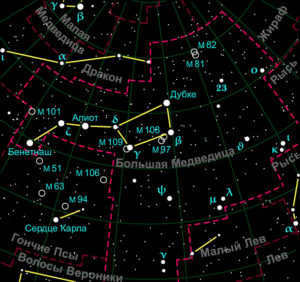
The Arabs describe the constellation as a “coffin with mourners”. The Chinese refer to it as the Plow, the Northern Bucket, or the Emperor’s Chariot. According to the Arabs, the three pairs of stars that form the feet of the Big Dipper – nu and xi, lambda and mu, iota and kappa – represent the footprints of a gazelle. On the other hand, the Chinese call them Santai, which translates to “three steps toward the sky.”
In Mongolia, the seven brightest stars are revered as the Seven Gods. The Iroquois view the three stars that form the tail of the Big Dipper as three hunters chasing after it. In India, the constellation is known as the Seven Sages, with each of the 7 brightest stars symbolizing one of the sages.
The Big Dipper is the third largest constellation in terms of area (after Hydra and Virgo), and its seven bright stars form the famous Big Dipper. Each star in the Dipper has its own Arabic name:
- Dubhe (α of the Big Dipper) means “bear”
- Merak (β) means “loins.”
- Fekda (γ) means “thigh.”
- Megretz (δ) means “beginning of the tail.”
- Aliot (ε) – the meaning is not clear (but most likely this name means “curd”)
- Mitzar (ζ) – “girdle” or “loincloth”.
- Benetnash or Alkaid (η) – Arabic for “leader of the mourners”.
In the system of designating stars with Greek letters, the order of the letters simply corresponds to the order of the stars.
The most brilliant celestial body in the configuration of the Great Bear’s Ladle
The Great Bear’s Ladle encompasses a total of 125 discernible stars that can be seen with the naked eye. However, the majority of these stars emit a rather feeble luminosity. Which star within the Great Bear’s Ladle shines the brightest? It is evident that the stars within the ladle itself outshine the other stars within the configuration, and, therefore, our selection must be made from among them. Yet, out of the seven stars comprising the Great Bear’s Ladle, one star clearly stands out – the star located at its very center, not as the most brilliant, but as the least luminous star! In reality, Dubhe (the alpha star of the Great Bear’s Ladle) is merely the second brightest, trailing slightly behind Aliot (ε). In third place, we find the star situated on the outermost end of the ladle’s handle, Benetnash (η), followed by the remainder of the stars.
The Story of the Big Dipper Constellation
Callisto, the daughter of King Lycaon in Greek mythology, served as a nymph in the company of the goddess Artemis. Her beauty caught the attention of Zeus, who disguised himself as Artemis to approach her unnoticed. This incident did not go unnoticed by the real Artemis, who discovered Callisto while she was bathing. As a result, Artemis expelled Callisto from her group, leaving the poor girl to wander the mountains while raising her son Arkas.
However, it turned out that the girl’s misfortunes did not come to an end. Hera, Zeus’ wife, discovered the birth of Arkas and as a punishment, she transformed Callisto into a bear. This was because Callisto had caused another instance of her husband’s adultery. Time passed and Arkas grew into a handsome young man. He had a passion for hunting and one day, while he was in the forest, he came across a bear. Unaware that it was his own mother standing before him, he swiftly reached for an arrow, pulled back the bowstring, and was about to strike the target, when suddenly Zeus intervened. The supreme god could not allow the crime to take place, but at the same time, he couldn’t reverse the actions of another god and restore Callisto to her human form. Recognizing that Callisto had suffered enough, Zeus transformed Arkas into a bear and then bestowed immortality upon both mother and son, placing them in the heavens. And thus, the constellations of the Ursa Major and Ursa Minor were created.
Written by astroson.com on April 24, 2017




